|
Indicator's second box set of films produced and directed by William Castle for Columbia marked something of a change in direction for a filmmaker who had risen to fame as the creator of horror and suspense movies, most famously ones with a colourful promotional gimmick. The films in this set are less well known than the likes of The Tingler or The House on Haunted Hill, and a couple seem to have been made with an even younger audience in mind than the teens at which his horror titles were targeted. Also significant is that only two of the films here actually had an associated gimmick as part of their sales pitch, although you could argue that teaming up with Britain's Hammer studio itself should have constituted a worthy selling point (as it turned out, it didn't), and on their commentary track, Lee Gambin and Emma Westwood make a case for the notion that leading lady Joan Crawford was the central gimmick of Strait-Jacket. All four films have their positive qualities, but I'll admit up front that I was not particularly enamoured with one of them. Personal taste, of course, and I've thus made my case why as inoffensively as I can.
Before I get to the films themselves, I'll give a quick shout for Indicator's policy of packaging each of the films in their box sets as stand-alone titles, with all four films here individually cased with its own (double-sided) cover artwork and booklet. The box in which they are all contained is also lovely.
Right, to the films.
Have you ever, maybe when you were younger and not yet the humanist you subsequently became, wondered what it would be like to have the power to hurt or humiliate someone simply by pointing a finger at them and saying a magic word? Maybe it's just me, although I'm fairly sure it's not. I distinctly remember emerging from the cinema after my first viewing of David Cronenberg's Scanners and trying to "scan" the usherettes, only to discover a few days later that my work colleagues – who had rushed to see the film on my enthusiastic recommendation – were doing likewise at anyone who came into their collective field of vision, myself included. Had I seen Zotz! as a child, I can absolutely guarantee I would have been rudely pointing my finger at people to see if I also had the power that is inadvertently gifted to its lead character.
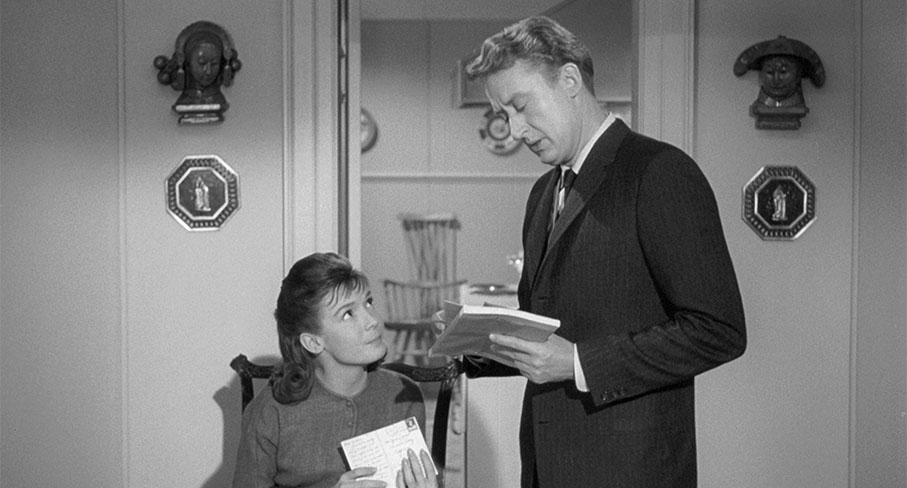
The man in question is Jonathan Jones, Professor of Ancient Languages at an unspecified university. His character is economically outlined in the opening minutes, as he jumps out of bed at the chime of his morning alarm, sucks in a lung full of fresh air from a nearby open window and launches into a series of bracing exercises, much to the tolerant weariness of his loving niece Cynthia, with whom he shares a house. After a bowl of dry wheatgerm and a glass of sauerkraut juice, he heads off to work on his pushbike, and in a sequence that eerily predicts the sometimes preoccupied behaviour of the mobile phone generation he becomes absorbed in a text book and pays no attention whatsoever to other road users, causing cars to swerve and pedestrians to drop their shopping when he distractedly almost collides with them. Sound familiar?
Early in the film Cynthia receives a letter from her boyfriend Eddie – one of Jonathan's prize former students who is now on an archaeological expedition in Ukranistan (where?) – that includes an ancient coin attached to a bracelet. It's an artefact Jonathan pays no heed to until he realises that the writing on the coin is in the dead language of Astyparaean (sorry?), and he is one of the few people in the world with the necessary skill to translate it. I've never heard of the Astyparaean language (not surprising since it was probably made up for the film), but its pictograms must have had far more depth to their meaning than their visual simplicity suggests – Jonathan translates on a word-by-word basis and gets an essay of detailed instructions from something like 23 small and uncomplicated symbols. The coin, once activated (it requires the drinking of blood, which Jonathan inadvertently does when he accidentally cuts his finger), gives anyone who has it in their possession three distinct powers. Simply point at someone and they suffer a sharp and instant pain in their abdomen (unless it's an aeroplane, then it will just follow the path of your waving finger – not sure how Jonathan worked out that would happen before he recklessly risked blowing an inoffensive plane out of the sky). If you say the word "Zotz!" at a person or object it slows down their movement to a crawl, and if you combine the two actions, then whatever you're pointing at will burst into flames or explode.
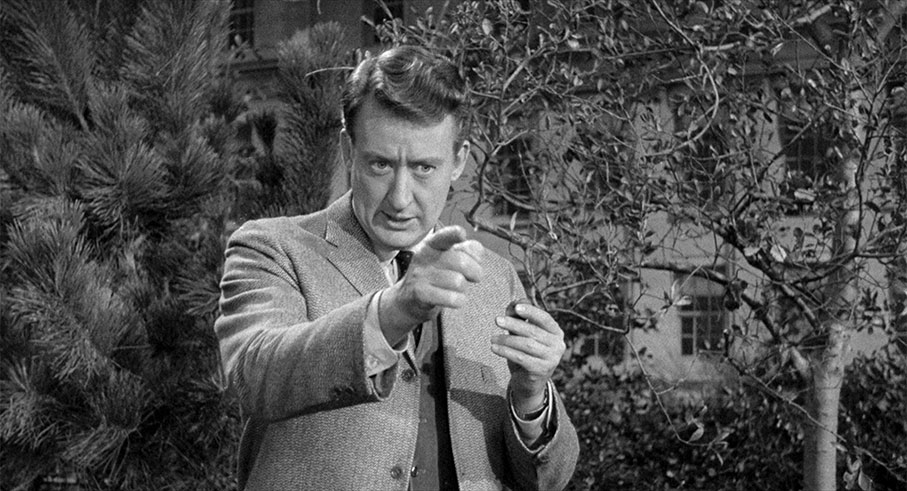
The process of Jonathan's discovery of the powers that the coin has gifted him are rather fun, as he inadvertently cripples two of his students when selecting them to give answers to scholarly questions (a regular activity that is deftly set up in an earlier scene), slows down the flight of a moth and then blows it out of the sky, and causes a branch full of berries to explode like firecrackers. Not every aspect of this journey of discovery is as effectively explored. As if to confirm that the smartest people sometimes don't have a milligram of common sense, Jonathan elects to demonstrate his new powers to the Dean not in the privacy of his office or the safety of a lab, but by taking a cage full of mice to the man's cocktail party and setting them loose with the intention of zapping them as they scurry around the living room floor. Why would anyone do this? The problem for Jonathan is that he doesn't actually have the coin with him and his powers are thus neutered, resulting in a scene of unfunny farcical comedy as well-to-do women squeal and leap on furniture, mice make their way into drinks and dresses, and the sort of black maid I thought was consigned to film history even in 1962 gets a jolt that prompts her to hurl a cake into the Dean's wife's face. Oh, how I laughed. More amusing is the revelation that Cynthia has taken the charm bracelet to which the coin is attached on a date with the dickhead son of Jonathan's academic rival, and is unknowingly flooring pedestrians by the dozen as she points out the direction in which they should head. Things complicate further in the third act, when Jonathan tries to sell his new skills to the American military, as while they're too cynical and distracted to take him seriously, agents of a less friendly government are not so blinkered, and a daffy comedy-drama evolves into a daffy spy story, one with just as many logic holes and inconsistencies.
I was not that surprised by the revelation in the extra features that prior to filming, Disney tried to get their paws on the project (although Castle himself is the key source for that claim, so it could be another piece of showmanship bluff), as it has all the elements of a zany live-action Disney feature of the era, and save for a moment when a woman is almost tortured with a hot iron by an enemy agent, it does tend to play like one. Having said that, there is plenty to be engaged and entertained by and even a couple of seriously forward-looking sequences. The most notable of these – Jonathan uses Zotz to slow down and thus dodge a bullet that has just been fired at him – has been cited by a number of commentators as prefiguring the Bullet Time effect in The Matrix, but it more precisely predicts a sequence in Charles Band's low budget 1984 sf thriller Trancers when time-travelling cop Jack Deth uses a special watch given to him before his temporal jump to do this exact same thing. I can't help but suspect that Castle's film was an influence there.
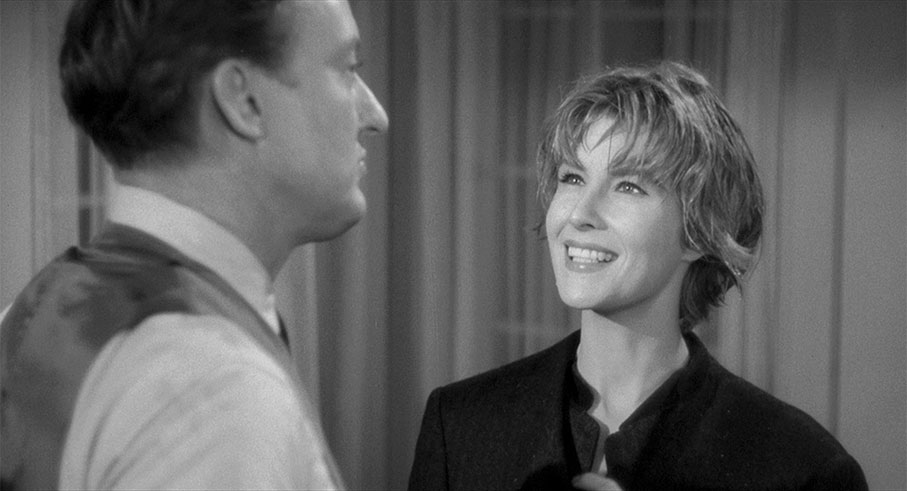
The cast is lot of fun. Tom Poston's penchant for looking nervously apprehensive works rather well for a film in which the lead character is repeatedly surprised and even alarmed by what is happening to him and those around him. I'd argue, however, that he is consistently outshone by Zeme North as Cynthia and particularly by the bewitching Julia Meade as Professor Virginia Fenster, whom Jonathan first meets when his Zotz experiments trigger a thunderstorm and a lightning strike that vaporises her clothing (could happen, I guess) and she rolls up at his house looking for shelter. That the two end up attracted to each other won't come as too much of a surprise to most viewers, but the fact that Jonathan is deeply embarrassed by her nakedness and clearly feels almost virginally awkward in her company, and is only attracted to her when he realises that she might be as smart as he is makes for an interesting variation of the standard movie meet-cute.
While the film lacks the in-movie gimmicks of Castle's celebrated horror titles, patrons who attended the American screenings did receive a plastic version of the Zotz coin to allow then to try out the power for themselves (I'd have loved this), and before the film itself kicks off Castle plays a cheeky game with the Columbia logo, which is briefly reprised at the film's conclusion. It's this sense of fun and Castle's willingness to play games with formulaic elements, coupled with the odd inventive and forward-thinking idea, a perhaps unintended undertone of sly cold-war commentary and the sense that the women in the film are often smarter and more level-headed than the men, that makes Zotz!, for all its small foibles, rather hard to resist.
As misleading titles go, this one's a doozy, given that there are actually 15 girls and that only one of them ever really gets to be frightened. Oh alright, that's not completely true, as when the school bus they are travelling in during the opening scene nearly crashes, there's a whole vehicle full of frightened girls, but if that's the scene the title is referring to then technically the movie should have been over five minutes after it began. And then there's the poster, with the image of a hand plunging a dagger downwards surrounded by a gaggle of screaming girls running in every direction. With that title and that poster it's clearly going to be a horror movie in the mode of some of Castle's previous works. Except that it isn't and never even makes an attempt to be so.
The tone for the whole film is set by that opening scene, as the uniformed girls march to the school bus in an orderly fashion and chirpy young American Candy Hull (Kathy Dunn) reveals in thoughts voice-over that they are all daughters of diplomats from various countries and are pupils at Miss Pittford's Academy for Young Ladies. And yes, in case you were wondering, Miss Pittford (Norma Varden) is one of those frightfully well-spoken and middle-aged English women that are always in charge of such academies in movies. The girls are going on holiday to London, and in a decision that throws common sense to the four winds, Candy has been allowed to drive the bus along a dangerous mountain road to the airport for no other reason than she won first prize in Latin. Just for the record, I was required to have a clean driving licence for two years and then take a specific driving test before I was allowed anywhere near the driving seat of a minibus. The wisdom of this decision is quickly called into question when a tarantula appears on the windscreen (from where, I might ask, given that we're supposed to be in Switzerland), causing Candy to swerve violently until she remembers that the vehicle has a brake. And so begins the colourful title sequence, which unfolds over iconic images of London and shots of various embassies as Van Alexander's bouncy score makes you wonder if you've accidentally sat down to watch a previously unseen Carry-On movie.

Then comes a scene that will likely prompt modern reviewers a little discomfort and even had this resolutely unshockable cynic raising his eyebrows, as the bubbly, 16-year-old Candy, still dressed in her pristine school uniform, pays a visit to 30-something special attaché Wally Sanders (Murray Hamilton) and only just stops short of tearing off his trousers in a relentless attempt to seduce him. He fights her at every turn but she's not easily dissuaded, even when he reminds her that he's engaged to be married to his long-term girlfriend, a fellow operative with somewhat curious name of Soldier (Joyce Taylor). Every bit as surprising is that when Candy's diplomat father walks and finds his daughter with her arms around the struggling Wally's neck, he reacts not with outrage but by smiling and saying, "Well, I might have known you'd be in here." Excuse me?
What these early do scenes do effectively accomplish is paint a picture of Candy as a girl who chases after what she wants regardless of the potential consequences or how she might have been told to behave by her elders, and as someone who will do anything to help the man on whom she has a monumental crush. It's thus not such a stretch that, when she overhears that the bigwigs in Washington are concerned about Wally's recent performance and that his job could soon be on the line if he doesn't start delivering some useful intel, she leaps at an opportunity to help him out by spying on Chinese diplomat Kang when visiting his daughter Mai-Ling (Lynne Sue Moon), with whom she is friends. By poking around and being subjected to one of the most absurd jump-scares I've ever witnessed (a screeching cat leaps onto her from heaven knows where while she's descending in a dumb waiter), she discovers the body of a murdered operative who is of particular interest to Wally and his team and has the self-control and savvy to anonymously deliver the news and the murder weapon to them. In no time at all she gets her hands on an espionage training manual (I'll buy the idea that this is something that her father might just own) and is soon finding creative ways to gather useful information and secretly pass it on to Wally under her chosen codename of Kitten.
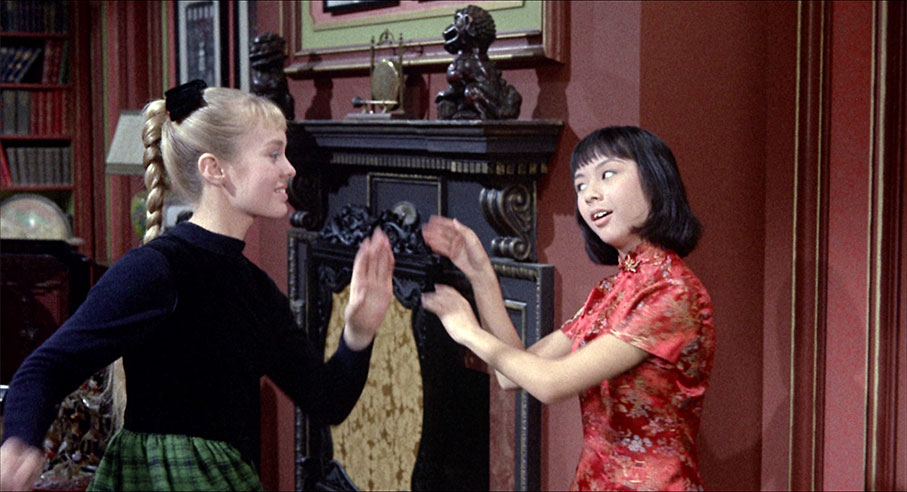
If you thought Zotz! had the air of a live-action Disney production – and I did – then wait until you get a load of 13 Frightened Girls, which from its "plucky young girl gets into mischief beating adults at their own game" plot and the preposterous nature of some of Candy's activities to the early film smiley cheerfulness and a colour palette that looks like it was chosen by Henri Matisse, looks every inch production of Uncle Walt's studio. That said, it's hard to imagine a Disney movie in which a teenage girl tries to so aggressively to seduce a far older man, and once everyone starts looking to track down and identify Kitten and what has previously been little more than a game to Candy takes a serious turn, the very real danger she subsequently faces really does step outside of the Disney norm, at least for the period (we're not talking Dragonslayer or Something Wicked This Way Comes here).
It's in the later stages that the film comes into its own, as the bubble of playful teenage fantasies is burst by the cutthroat world of international espionage, and the confidence Candy has gained through her earlier success and the notoriety her secret identity has garnered leaves her unprepared for the dangers that await her. Spy thrillers were in vogue in the 1960s, but with that in mind what intrigues here is Candy's close friendship with Mai-Ling and even Mai-Ling's strong relationship with her father Kang. That the Chinese (or, as they are sometimes referred to here, the "Red Chinese") are shown to be up to no good is hardly surprising in a film that was made when all communist-leaning countries were still regarded as legitimate movie bad guys, and the fact that there's a discomfortingly stereotypical edge to how they are portrayed is also not unusual for a film of its day. What does surprise is that Kang is not portrayed as an ieredeemably evil super-villain, but as a cheerful father who clearly loves his daughter, one who walks in on Mai-Ling and Candy dancing to decadent western music and instead of being angry appears tickled pink to find her having so much fun with her American friend. That he is revealed to be up to no good and later puts Candy's life in serious peril even after Kitten's true identity is revealed, and even at one point hits Mai-Ling in anger, does take the shine of his previously pleasant demeanour, but a later reunification with his daughter feels included almost to remind us that even potentially murderous diplomats and spies have a human side.
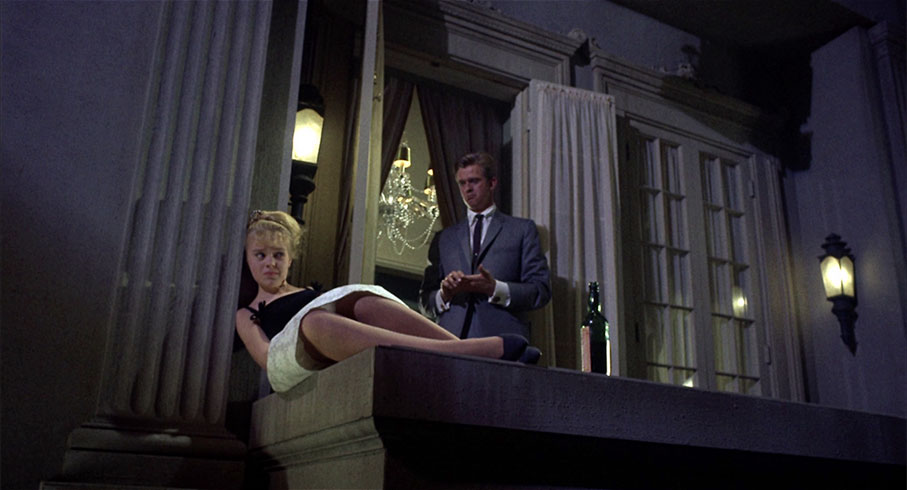
Even when things take a darker turn, Castle never forgets that this is primarily an entertainment targeted at a younger audience, which we can presume explains a late-story switch from life-threatening danger to daffy comedy when Candy is pursued by two Chinese assassins and their efforts are foiled by her classmates ("Damn you meddling kids!") in manner that doesn't stand up to any sort of scrutiny and seems designed primarily to steer the film towards a more light-hearted conclusion. Silly though it is, this does no serious harm to a lively and effervescent cross-genre coming-of-age story, one whose adult characters, in spite of their top billing, are essentially there primarily to support the two engaging and likeable juvenile leads.
The theory goes that if you're going to remake a classic then you need to bring something new and substantial to the table. Whether William Castle meets these requirements with his colourful 1963 remake of James Whale's comedy-horror masterpiece from 1932 is likely to be a matter of personal taste, but the general opinion for some time has been that his movie falls considerably short. I remember seeing it many years ago and groaning my way through it, and thus gave an almost unconscious nod of agreement when it was curtly dismissed by genre writers Kim Newman and Stephen Jones on their commentary track for last year's Eureka Blu-ray release of Whale's original. I was thus intrigued to discover that these two had also been engaged to provide a commentary on Castle's remake, and couldn't help but dip into that even before re-watching the film, and to my (and, to be fair, their) considerable surprise they admitted to enjoying it a lot more this time around. This raised an obvious question over whether I also could have misjudged the film. It has, after all, been something like three decades since I first saw it, and tastes do often change and broaden over time. I thus prepared myself for a pleasant surprise.
It certainly gets off to an intriguing start. Tom Penderel (Tom Poston from Zotz!) is an American car salesman living in London who has an interesting living arrangement with his very British flatmate, Caspar Femm (the inimitable Peter Bull) in which he occupies their apartment by night while Casper has it during the day. As the film opens, Tom arrives at an exclusive casino to deliver one of those oversized American coupés to Casper, who's always wanted to own such a vehicle. In the course of their conversation, Casper gloomily reveals that he has to return to the Dartmoor family home of Femm Hall each night and he all but begs Tom to join him at the house for the weekend. There's a nice moment here when Casper says to Tom, "You can meet my cousin. She'll like you. You're likeable," a line that irresistibly reminded me of a moment in the later Sexy Beast when the terrifying Don Logan says to retired gangster Gal, in a way that manages to be threatening without specifying the threat, "I love you, Gal. You're loveable."
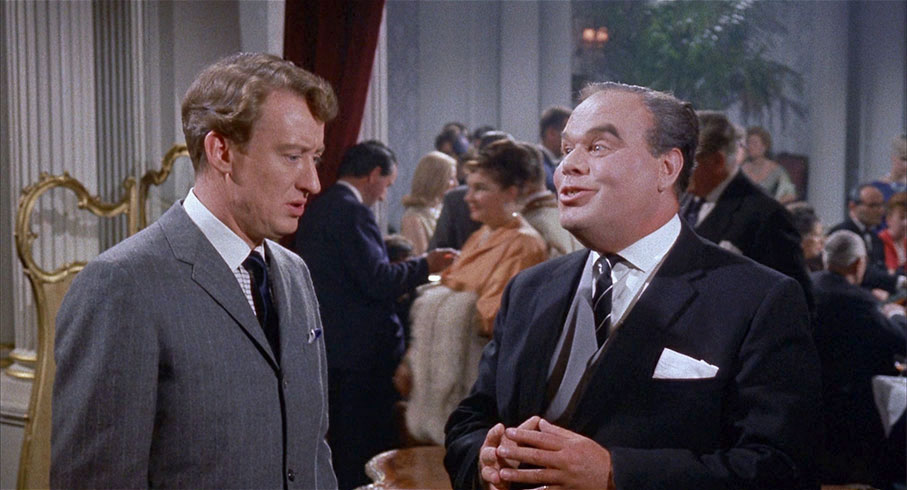
In the name of friendship, Tim accepts the invitation, but when Casper announces that he intends to make the journey by plane, Tom has to drive there on his own in Casper's new car. Even before he arrives at Femm Hall things start to go wrong for him. A thunderstorm breaks out as he approaches, a statue falls from the Hall's sizeable gatepost and wrecks the car, and when he rings the front doorbell a trapdoor opens and deposits him in the cellar. Here he meets the slightly batty Potiphar Femm (Mervyn Johns), who leads him to a room in which Casper is lying in a coffin, he having arrived and somehow perished during the course of Tom's lengthy drive. Soon he is introduced to the rest of the Femm brood, whose characteristics appear to be defined primarily by the actors cast to play them. There's Casper's sweetly dotty mother Agatha (Joyce Grenfell), his pompous brother Roderick (Robert Morley), his attractive female cousin Cecily (Jeanette Scott) and outrageous flirt Morgana, who's played to the seductive hilt by Fenella Fielding in what retrospectively feels like a warm-up to her memorable role in Carry on Screaming. It's Roderick who delivers the news that a combination of bad weather and local flooding means that Tom will have to spend the night at Femm Hall, which is how he comes face-to-face with Morgana's silent but brutish and fiercely protective father Morgan (Danny Green), and how he discovers that Caspar has an identical twin named Jasper. As characters, they're nowhere near as collectively colourful or entertaining as the Femm family of 1932, but are still more interesting than the hapless Tom, who is played by Tom Poston with the an expression of constant nervous uncertainty but little in the way of real charm or charisma.
The essence of this setup is certainly similar to that of Whale's original, but tonally the two diverge from an early stage. Where in Whale's film there is a genuine and constant air of potentially dangerous madness to the family Femm, in Castle's there's an artificiality to their colourful but ultimately harmless and even charming eccentricities. The wonderfully named Potiphar's obsession with building a biblical ark for the upcoming flood does has some mild amusement value, and there's entertainment aplenty in Morgana's vampish attempts to seduce the peculiarly resistant Tom (what's wrong with this guy?), but as the film progressed, the Femms started to remind me of TV's The Munsters, a connection emphasised by the presence of seemingly out-of-place blonde beauty Cecily. It's worth noting, however, that Castle's film hit theatres a year before the first episode of The Munsters was screened, and in a nice little piece of chance one-upmanship, the film's splendid opening credits were designed by none other than Charles Addams, on whose cartoons Munsters rival The Addams Family was soon to be based.
This tonal difference from the original film is further emphasised by comic action that has a brash silent movie quality about it and a boisterous and sometimes Souza-esque score by Van Alexander, one that in its liveliest moments sounds almost as if the musicians were running at full speed with their instruments after swallowing their twentieth strong caffeine hit of the day. The colour cinematography and lush production design by Hammer regulars Arthur Grant and Bernard Robinson are of a very high order, but Castle's direction is unadventurously by the book, framing characters almost exclusively at head height and from unsurprising angles and displaying none of the expressionistic invention that was to enliven the fourth film in this set (more on that below).
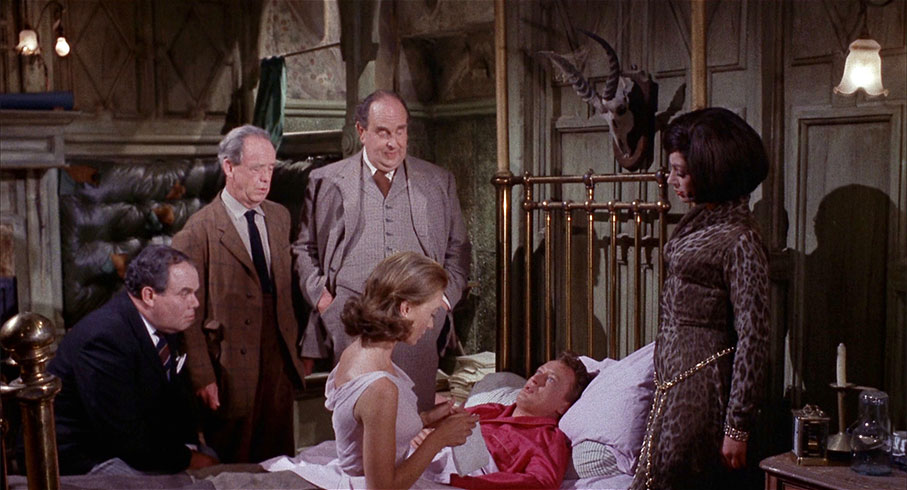
So did I enjoy it more this time around than on that dismissive first viewing? Well yes, sort of, but with a sizeable caveat. I'll freely admit that I'm such a huge fan of the original film that any remake is going to have to be something really special to come close to matching it, and my view is further coloured by a preference for the sort of wonderfully twisted black comedy that Whale made his own over odd blend of wacky slapstick and too-genteel eccentricity that marks Castle's approach. There are moments in the first half that I definitely enjoyed, but as the film progressed, the by-the-numbers direction – coupled with comedic antics that I didn't find funny, a leading man I didn't warm to and an worn plot enlivened only by a couple of credibility-stretching surprises – steadily wore me down. The climactic, semi-farcical chase around the house to locate bombs before they explode proves more entertaining than the build-up to it had led me to expect, but still feels like a missed opportunity to stage a scene that actually has some tension. The result is a quaint and intermittently entertaining horror-comedy with an impressive supporting cast, but for me it's not scary, it's not funny, and it's not a patch on the magnificent original that it is ostensibly a remake of.
If there were prizes awarded for no-nonsense, in-your-face film pre-credit sequences, William Castle's 1964 psychodrama Strait-Jacket ('Straight' is one of those words that clumsily lost a couple of its letters on its journey across the Atlantic) would certainly be in the running. Following a brief but ear and eye-busting montage of screams and semi-abstract imagery, a newspaper mock-up with an undersized headline ("Love Slayer Insane") and a drawing of a mad-looking Joan Crawford is blasted towards the camera. This is accompanied by one of those voices that's meant to sound like someone hawking papers on the street ("Read all about it!"), after which a somewhat calmer female voice informs us that, "Lucy Harbin was declared legally insane today." Cue lively swing music blaring out of a roadside tavern juke box and we've been taken back to be shown what led up to this legal decision, guided, we later discover, by the voice of Lucy's now grown-up daughter Carol. Here we meet Lucy's gold-digging younger husband Frank (played by an uncredited Lee Majors in his first film role), who's drinking and getting friendly with his lively ex-girlfriend Stella while his wife is out of town. They then go back to Frank and Lucy's place and do that thing you should never do in a movie (or probably in real life if you want to avoid trouble) and have it off in the marital bed. Perhaps inevitably, Lucy – whom Carol nicely describes as "very much a woman, and very much aware of the fact" – arrives home early, and in a less explicit version of a moment we've become familiar with through the likes of John Landis's Into the Night and Imamura Shohei's The Eel, she peers in through the bedroom window and realises immediately what's been going on. Her response is a lot more Imamura than Landis, as instead of walking away in despair, she picks up a felling axe, walks into the bedroom and cuts off both their heads, then proceeds to decimate the bodies with a wild stream of savagely delivered axe blows. This must have been a genuinely shocking sequence for its day, partly because you see the first beheading, albeit in shadow, but primarily because of the ferocity of the attack that immediately follows. Making matters worse is that the then young Carol witnessed the whole horrible thing, and we then flash forward to the present day, where the now adult Carol is preparing to meet her mother again for the first time since the killings, due as she is to come home after spending 20 years in an asylum. Cue main title. That's quite a bit of plot for just six minutes of screen time.
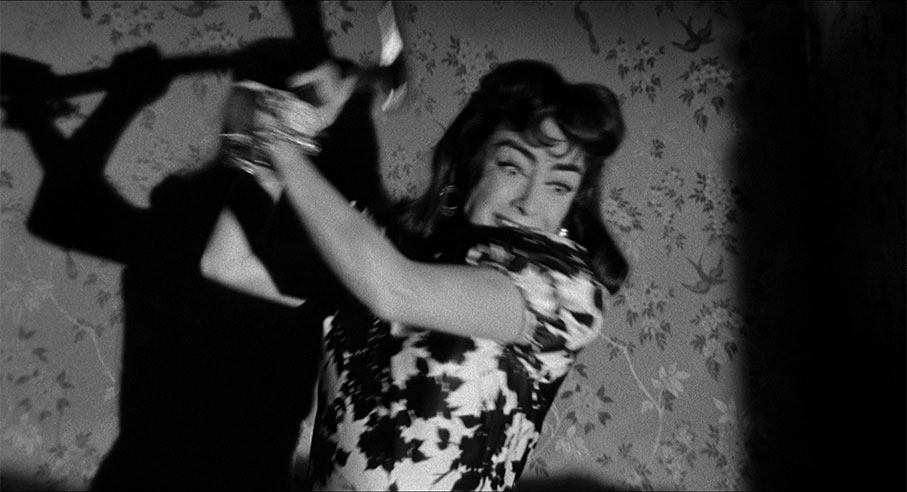
Unsurprisingly, the now considerably older and more delicate Lucy is a tad apprehensive about being reunited with a daughter she's not seen since she was a child. Helpfully, Carol has moved far away from the former family home and now lives on a small farm with her kindly uncle Bill (Leif Erickson) and aunt Emily (Rochelle Hudson). She also has the support of her devoted boyfriend Michael (John Anthony Hayes), the boringly straight-laced son of Bill and Emily's well-to-do and judgemental neighbours Raymond and Alison Fields (Howard St. John and Edith Atwater), and after some initial hesitation she warms to her mother and takes a strong interest in her future wellbeing. To this end Carol encourages Lucy to dress as her younger self, as the mother she remembers, but the clothing and wig she selects has a transformative effect on Lucy, and her increasingly erratic behaviour soon becomes a cause for concern.
And that's as much as I can safely reveal without getting into serious spoiler territory, but in order to discuss in any meaningful detail much of what is so interesting about the film and what doesn't work so well, that's what I'm going to have to do. Some of what I'm about to talk about you'll find heavily hinted or even openly revealed in the film's publicity material, and the biggest spoiler of all will not be a surprise to a good many of those who sit down to watch the movie, probably for the same reason it wasn't to me. The curse of movie convention has seen to that. That said, if you want to avoid any spoilers then hop to final paragraph of this review or click on this link to scroll the screen down to there. Be it on your own head if you choose to read it anyway.
Last warning – here come the spoilers. Right. The biggest issue for me is that the film's big climactic twist didn't surprise me at all. Indeed, I saw it coming from a disarmingly early stage, and the more perceptive may even pick up on clues dropped in the pre-title sequence. Part of the reason is that the twist in question was done to death in the years that followed the release of Strait-Jacket and had even been employed – often successfully – by a fair few films of varying genres before being recycled for the key plot twist here. The problem lies primarily in the fact that the film makes such an effort to misdirect us that this misdirection becomes clearly visible for what it is. Almost from the moment Lucy arrives home her behaviour feels contrived specifically to cast suspicion on her, and once people start being killed with the very same type of axe that Lucy employed to dispatch her husband and his lover, the fact that we never clearly see the assailant's face all but confirmed to me that Lucy was being set up by someone else. This in itself probably wouldn't have been such an problem (it is, after all, the modus operandi of a good many Italian giallo thrillers) if it wasn't so obvious to me who the killer really was. Thus, when the big moment of supposedly shock revelation came and the person I had suspected all along was exposed as the actual perpetrator for the very reason that I had predicted, instead of being surprised I just gave a small 'thought so' shrug.

If you can live with this, however, there is a great deal to enjoy here, and a second viewing proves fun anyway for some nicely done foreshadowing and the small clues that are dropped along the way that are subtly pointing you to the truth. There's a rather obvious but enjoyable red herring in the shape of sleazy farmhand Leo Krause (nicely played by a young George Kennedy), and once he cottons on to what he believes is going on and foolishly moves into cocky blackmail mode, it's hard not to get a little bit fired up for his inevitable demise, which is the most explicitly violent in the film. Tension is nicely built and the influence of Hitchcock and especially Psycho – a connection underlined by the fact that the screenplay was written by Psycho author Robert Bloch – can be felt in the way that some sequences are constructed and framed, peaking in an extraordinary top shot of Lucy having a panic attack in a nightmarishly decorated washroom, a scene that plays initially like a flashback to the asylum but is then to be revealed to be happening in the here and now. There are even a couple of blackly humorous moments when Carol is showing Lucy around the farm and she has to check herself after talking about animals being butchered or reared for slaughter. Also intriguing is a moment when Lucy watches on in horror as the juiciest beef joint in America is carved for dinner, and a sequence in which she becomes so possessed by her transformative clothing that she comes on heavily to Carol's boyfriend while her daughter looks on (at one point she even puts her fingers playfully in his mouth). All of these and a few more are just off-kilter enough to have you doubting your initial predictions about who the murderer might be.
The film's chief attraction, however, just has to be Joan Crawford, who plays the troubled Lucy with everything she's got, unafraid to go the whole nine yards when her character really loses it but still able to reign it in most effectively for the quieter moments and doing an excellent job of selling the notion that Lucy is mentally coming apart at the seams. There's one almost throwaway moment in her performance that really struck me, when she's interviewed by Dr. Anderson (played woodenly by Mitchell Cox, a Pepsi Cola bigwig who only got the role because fellow board member Crawford demanded it) and he asks her if she ever feels lonely. The look on her face, the small, distant pause for thought and the intriguing way she delivers the word "no" suggests a whole backstory of past experience worthy of deeper exploration. There's very solid support from Diane Baker as Carol, the ever-reliable Leif Erickson as uncle Bill and the aforementioned George Kennedy as farmhand Leo Krause, and Castle's direction is a lot tighter and intermittently more stylish and inventive than his more pedestrian handling of The Old Dark House. Predictable though the principal plot twist might be, the journey to its revelation is so well handled and so entertaining that I couldn't wait to give it a second viewing.
Another strong set of transfers from Indicator, although there is some small variance in the (always high) quality, presumably due to the condition of the original film materials. All are framed in their original aspect ratio of 1.85:1 and all have Linear PCM 1.0 mono soundtracks. Zotz! and Strait-Jacket were shot in black-and-white, while 13 Frightened Girls and The Old Dark House are in colour. All have been impressively cleaned up and remastered and are largely free of dust or damage, and all have optional English subtitles for the deaf and hearing impaired.
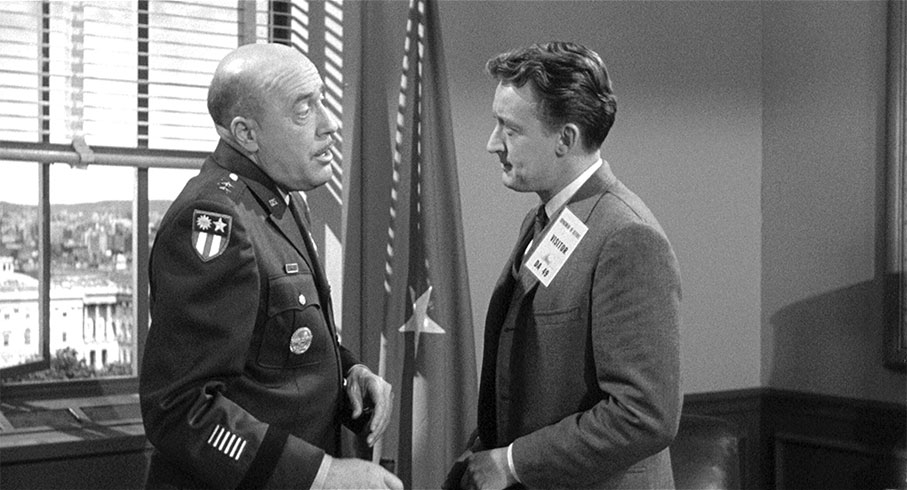
The contrast on Zotz! is beefy enough to produce blacks so solid that they almost suck in the surrounding dark detail but pleasingly never do – it's a similar story with the whiter highlights, which seem as if they're itching to burn out but the detail is always preserved. Nice job. The detail is good but not quite as crisp as a couple of the other titles in this set, and there's a light film grain visible throughout. A few minor scratches are still visible, but they appear to have been treated so as to be hardly noticeable. The soundtrack has the expected limits on the dynamic range, but the dialogue and music are clear.
13 Frightened Girls is the loveliest looking film in this set, thanks in no small part to its vibrant colour palette and the sublimely pitched contrast that nails the black levels but never feels harsh, with no detail lost at either end of the range. The picture is commendably crisp, though does soften just a whisker in a handful of shots, though you'd be pushed to notice unless you have your nose pressed to the screen as I did and you'll have to get similarly close to see the very fine film grain. The soundtrack is again clear and free of noise or damage, with the music sounding especially good. This is also the loudest soundtrack in this set. It should be noted that three versions of the film have been included, allowing you to watch it as 13 Frightened Girls or under the (frankly better) original title of The Candy Web, or as The Candy Web bookended by William Castle telling you about the films 'Danger Card' gimmick, which is not one of his best.
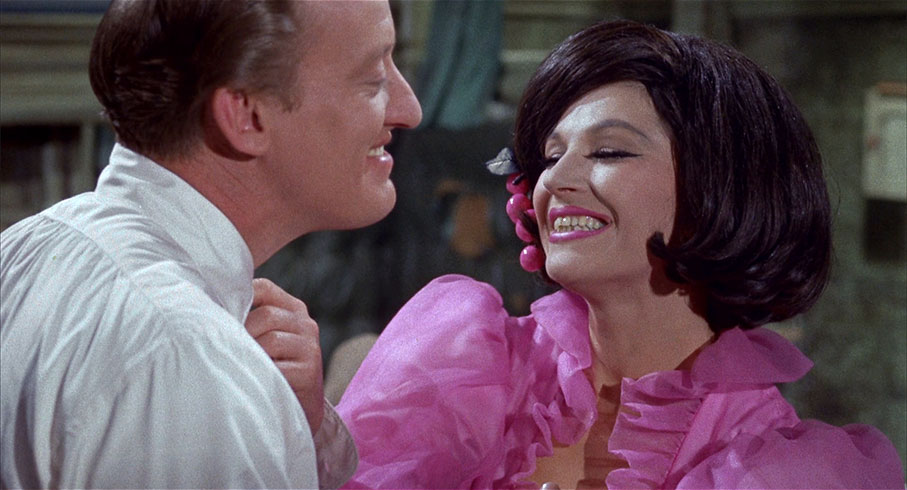
The Old Dark House also looks a treat, handsomely showcasing Arthur Grant's colour cinematography, whose lighting was clearly designed to ensure that no picture information became lost in the shadows, despite the film being primarily set at night. The colour is very good and really pops when required (just about everything Fenella Fielding wears leaps out of the screen) and the contrast is impeccably graded throughout. The soundtrack is on a par with the other titles in this set – the score sounds very clear, though the thunderclaps lack any bass and sound a bit tinny at times, something we can put down to the original sound effects. As well as the colour version, Indicator has included the black-and-white version that Columbia released in the US, which looks all wrong for the simple reason that the rules for lighting monochrome are completely different to those for colour, and without colour to clearly separate characters from their surroundings it thus looks a little flat. Also available is the British 'A' certificate version, complete with the BBFC requested cuts. Since my humble Blu-ray player claims that this has exactly the same running time as the other two versions, I'm assuming that this was achieved using branching.
The Strait-Jacket transfer has the most visible film grain and it seems to be more prominent in some scenes than others, but it's not in any way distracting and feels right for the movie. The contrast range is again nicely judged and to my eyes has slightly more generous tonal range than Zotz! without softening the black levels. Detail is crisp throughout. Dialogue and music are clear throughout within the expected restrictions – the treble bias is most evident when Carol is putting cutlery away and the finesse of the sound is lost in a shrill metallic clatter.
ZOTZ!
Audio Commentary with Kat Ellinger
If you employ Kat Ellinger to provide a commentary on a movie then you know she'll come with her metaphoric arms full of fascinating facts about the title in question as well as pertinent analysis of its content. This is no exception. Topics covered here include the differences between the film and the Walter Karig novel on which it was based, William Castle's film career and what made him special, how the film taps into a number of comedy trends of the period, the actors, the characters, the underlying themes, and a whole lot more. Some of this is screen-specific while the more general discussions often go into considerable detail. There's a lot to digest here, all of it worthwhile.
Introduction by Stephen Laws (6:06)
Horror novelist and lifelong William Castle fan Stephen Laws recalls first seeing and loving the film as a child, talks about specific cast members and the author of the novel, and bemoans the fact that the Zotz coins were only handed out to American audiences.
The Horror of It All (24:00)
Genre novelist and critic Kim Newman provides a detailed introduction to the work and career of Zotz! screenwriter Ray Russell, from his early days as Playboy's fiction editor to his novels and his movie screenplays, which include Mr. Sardonicus for William Castle and Premature Burial and X: The Man with the X-Ray Eyes for Roger Corman. I learned a lot here.
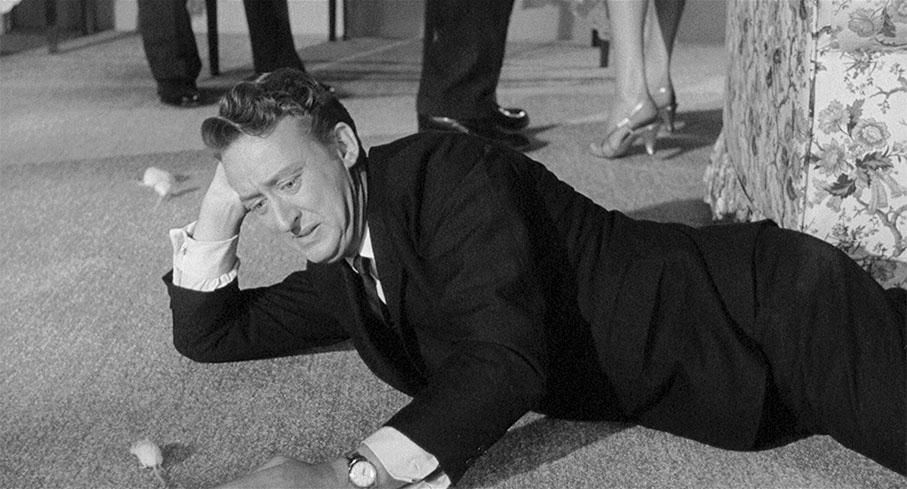
Isolated Music & Effects Track
Here for those who like this sort of thing.
Theatrical Trailer (2:41)
There are a couple of spoilers in a trailer that does capture the film's sense of fun and assures us that "plots to steal Zotz land the professor in hot spots!"
Image Gallery
59 slides of promotional photos and posters, including studio portraits of actors and a couple of behind-the-scenes stills.
Booklet
Leading the way here is an informative essay on the film and it's source novel by Joe Jordan, author of Showmanship: The Films of William Castle, which is followed by an extract from William Castle's colourfully titled autobiography, Step Right Up! I'm Gonna Scare the Pants Off America in which he talks about the development and reception of his first family-targeted comedy. Next we have a useful piece on author Walter Karig and the origins of his novel, Zotz! – from which a number of extracts are also quoted – and how it differs from Castle's film adaptation. A reproduction of a short 1961 piece by Bob Thomas on the film's stars that first appeared in the Pittsburgh Post-Gazette is followed by an article written in 1962 by Carla Lowry for the Terre Haute Tribute that focuses on Castle's typically colourful promotion of the film. There's a interesting essay by Jeff Billington titled The Legacy of William Castle, and bringing up the rear are a small selection of contemporary reviews. Full credits for the film, promotional and production stills and a poster have also been included.
13 FRIGHTENED GIRLS
Audio Commentary with Samm Deighan
Associated editor of Diabolique Magazine, Samm Deighan, reveals up front that she believes that 13 Frightened Girls is a seriously underrated film and then proceeds to explain why so persuasively and in such authoritative detail that I had to go back and re-watch the film with fresh and more appreciative eyes and ears. She provides details of the highly publicised process of casting the schoolgirls (and even lists the nations they are supposed to represent), highlights the symbolic role of China in the film and the international political climate in which it was made, explores in considerable detail the connection between Candy's adventures and those of Nancy Drew (look her up if the name is new to you) and links to later Castle films I Saw What You Did and Let's Kill Uncle, and salutes the strength of the film's key female characters. Unlike Stephen Laws (see below), she regards Candy's crush (pun intended) on the older Wally as rather sweet. There's lots more here, all of it good.
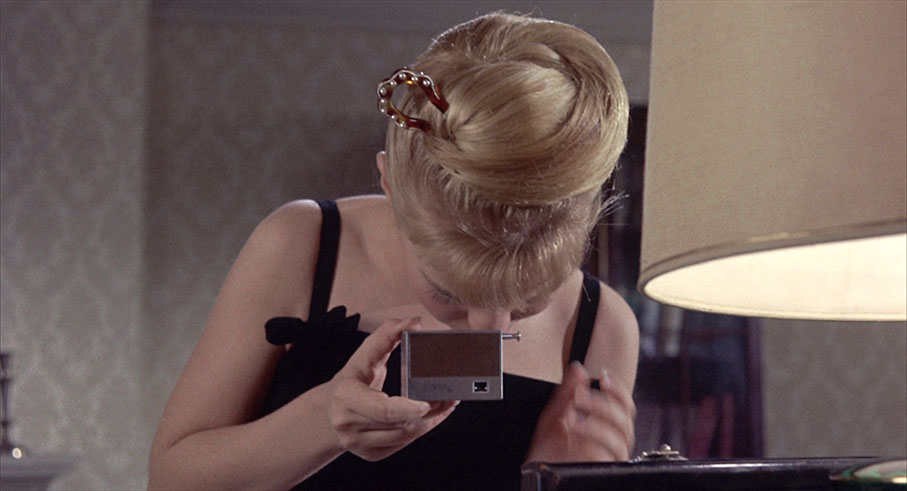
Introduction by Stephen Laws(10:21)
Despite his professed love of all things William Castle, Laws is a little more guarded about his enthusiasm for 13 Frightened Girls, describing it as a film with an identity crisis and clearly very uncomfortable about the scene in which Candy attempts to seduce the far older Wally, which he goes as far as calling "difficult to watch." He delivers useful info on some of the cast, and discussion of a later plot twist is preceded by a nicely executed William Castle-esque spoiler warning.
William Castle 'Danger Card' Messages (1:26)
An opening and closing address to the audience by William castle that was attached to the film when it played under its original title of The Candy Web and refers to a card that the audience members were handed on entry.
Alternative Opening Scenes (3.55/3.56 each)
Castle suggested in his autobiography that he shot separate versions of the film for each of the countries represented by the nationality of the students, but those who have researched this have found no evidence to back it up and have concluded that the claim is another example of Castle's showmanship bunkum. What he does appear to have done, however, is shoot a separate opening sequence for each of the represented countries in which that nation's student is the Latin prize winner and allowed to drive the bus, and they who provide the opening thoughts monologue. The British, French, German and Swedish opening scenes are presented here for comparison purposes – all four have the exact same running time (give or take a second) and each girl delivers her voice-over in her country's native language. On the British print the bus is driven by a young Alexandra Bastedo, whom fans of cult 60s TV will remember from The Champions, while devotees of Italian horror will doubtless recall her strikingly strange first appearance buried on a beach in Vicente Aranda's 1972 adaptation of Sheridan Le Fanu's Carmilla, The Blood Spattered Bride [La novia ensangrentada].
Isolated Music and Effects Track
It's here if you want it.
British Trailer Introduction (0:38)
Alexandra Bastedo (whom I once saw unfortunately mis-credited in a print publication as Alexandra Bastardo) delivers a trailer introduction in a voice so posh it makes the Queen sound almost like a market stall barker by comparison.
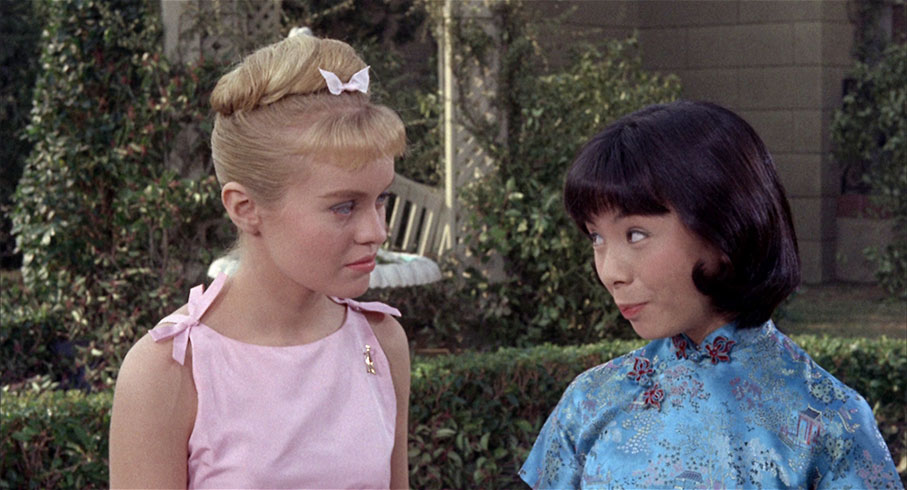
'13 Frightened Girls' Trailer (2:36)
A spoiler-peppered trailer that plays on the contest to select a cast of girls of different nationalities and confusingly introduces 14 of them (if you include Candy and Mai-Ling), which sits slap-bang between the actual and the publicised number of students.
'The Candy Web' Trailer (2:31)
A similarly spoiler-littered trailer with different captions and narration and some alternative clips but no parade this time of contest-winning girls.
Image Gallery
22 slides of promotional photos, horribly coloured front-of-house stills and delightfully misleading posters.
Booklet
A solid new essay on the film by Rachel Nisbet is followed by another entertaining extract from William Castle's autobiography, this one focussing on the production of the film and its international casting process. There's a surprisingly and pleasingly detailed piece on that casting gimmick, and an interview with associate producer Dona Holloway, which has been assembled from a number of sources. A couple of contemporary reviews have been quoted, and full credits for the film and promotional photos and artwork have also been included.
THE OLD DARK HOUSE
Audio Commentary with Kim Newman and Stephen Jones
Having dismissed the film on their commentary on Eureka's Blu-ray release of James Whale's original, here genre writers Kim Newman and Stephen Jones kick off by admitting that after watching the film again they found themselves really warming to it. Inevitably, they and I do not see eye-to-eye, but as ever with the duo, the sheer volume of facts and opinion delivered about the film, its cast and its makers means that I have no complaints.

Not Too Spooky (28:37)
Jonathan Rigby is back to provide a detailed breakdown of the film's inception, production and less-than-successful release on both sides of the pond. He highlights its strengths – particularlyHammer regular Bernard Robinson's production design, the exterior locations and the British supporting cast of celebrated thespians – but shares my view that the eccentricities of the Femm family are too amiable and lacking a sense of danger. He questions why Robert Dillon's screenplay threw out almost everything distinctive from both Whale's original and J.B. Priestley's source novel, and touches on why the verbal comedy doesn't really work, though is clearly a bigger fan of the more slapstick elements than I.
House and Castle (7:22)
Dr. Paul Firth of the University of Anglia put the film in context with Hammer's output of the time and with other films that were reshaping the censorship landscape, touches on its use of colour and discusses its problematic release.
Isolated Music and Effects Track
Not being a fan of the sometimes frantic score, this is not one I'll be kicking back to any time soon.
Theatrical Trailer (2:47)
Structured in the manner of an estate agent sell (well, sort of), this spoiler-peppered trailer downplays the comedy and suggests a spooky ride, and frankly doesn't do a very convincing job of it.
Stills, Lobby Cards and Posters
A gallery of 75 HD slides containing the very material outlined in the title. Includes a shot of Tom Poston posing with a British Bobby but surprisingly only a couple featuring William Castle.
Press Books and Promotional Material
A generous 69 slides of scans from the film's press books, at a resolution that makes it easy to read on a decently sized screen, and there's plenty to keep you occupied here.
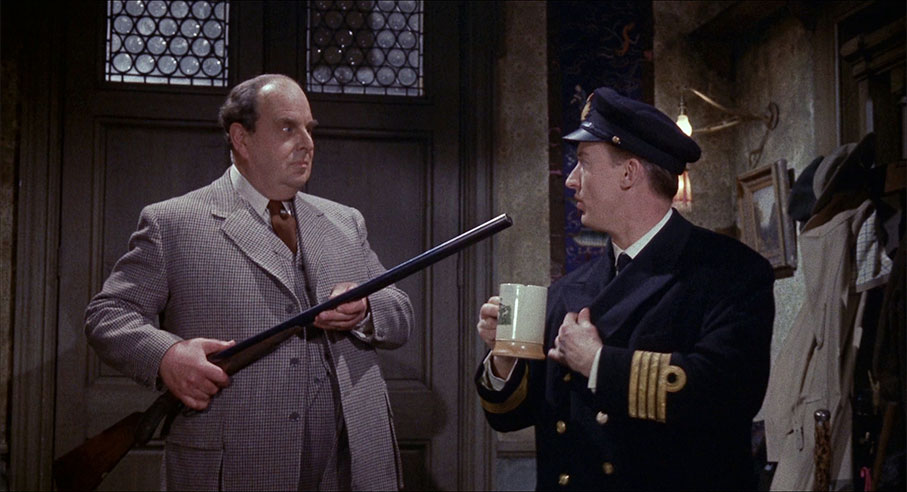
Booklet
Heading up this booklet is a spirited defence of the film's qualities by James Oliver, one that also serves as a handy reminder that comedy is very much a matter of personal taste. As The Old Dark House doesn't even get a mention in William Castle's autobiography, his comments on the film a represented here by a piece he wrote for Hammer's promotional manual, which is followed by an brief but interesting interview with J.B. Priestly on his novel, Benighted, and its film adaptations (the second of which he hadn't seen, it should be noted). Next is a really detailed and painstakingly researched article by Anthony Nield on Hammer's battles with the BBFC to secure the certificate they wanted, after which we have extracts from Columbia's attempt to pull off a few Castle-like gimmicks to promote the film, and extracts from three contemporary reviews. No real surprise that Monthly Film Bulletin really hated it. Full credits for the film and promotional material are also on board.
STRAIT-JACKET
Audio Commentary with Lee Gambin and Emma Westwood
Writers and film historians Lee Gabin and Emma Westwood are with us again to enthuse energetically about Strait-Jacket and deliver a wealth of often insanely detailed information on the actors, the sound editing, the score, the filmmakers, the supporting characters, related movies and a whole lot more. Unsurprisingly, there's a lot about Joan Crawford, but impressively this doesn't duplicate their content from Indicator's Berserk disc, where Crawford was also a principal subject of discussion. We even get a bit on the use of pigs in films. It makes sense when you hear it.
Mirror Images (27:19)
Here Jonathan Rigby – whom I have to salute for being so consistent in the length of time he talks about each film – discusses the influence of Psycho and Whatever Happened to Baby Jane on Castle's approach and choice of project, the original concept for the killer and how things changed once Joan Crawford came on board, the uncomfortable way the film suggests we should be disturbed by an older woman's carnal desires, Van Alexander's score, and more.
Joan Crawford Had Me Fired (6:45)
In what looks like one of several extras licensed from earlier an DVD release (all of these are framed 4:3 and have the same distinctive title font and appear to have been produced by Automat Pictures), actor Anne Helm provides some revealing first-hand insight into how she was hired by William Castle to play Carol and then, after an extremely positive first meeting with Joan Crawford, how things subsequently fell apart and a furious Crawford eventually demanded she be fired.
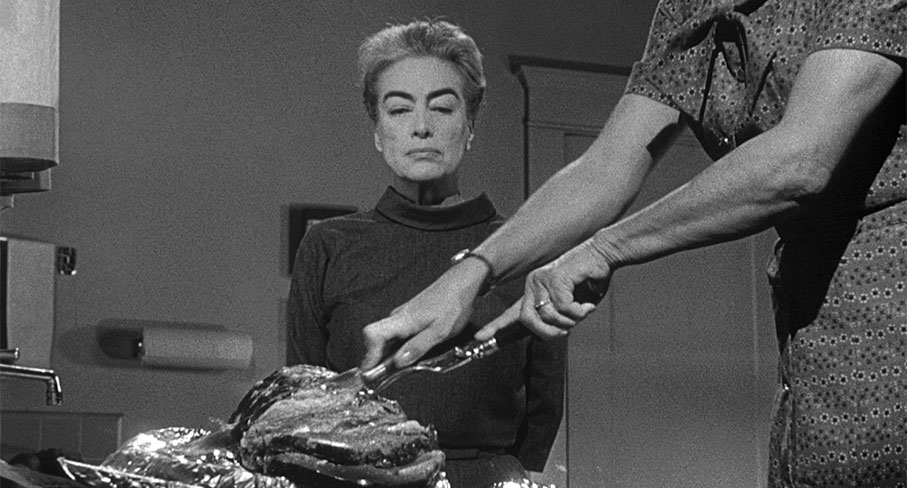
On the Road with Joan Crawford (6:33)
In another 4:3-framed Automat production, Richard Kahn from the Columbia Pictures publicity department talks about the movie's inception and the plan to bring Castle and Crawford together, strongly suggests that Crawford effectively co-directed the movie, and outlines the ways in which she dictated how the film's publicity tour would play out, something that she apparently threw herself into. He also fondly remembers everyone being invited up to her apartment for coffee at the end of the day, and says revealingly, "Although we all treated Joan like a star, she knew how to treat the people who made her a star." After watching the previous special feature, I have a feeling Anne Helm might beg to differ.
Battle-Axe: The Making of Strait-Jacket (14:39)
In a third feature sourced from an earlier DVD, film historian David Del Valle and actor Diane Baker – with brief contributions from film historian Don Glut and Columbia Pictures repertory Michael Schlesinger – discuss the production of Strait-Jacket, covering the significance of Whatever Happened to Baby Jane (which William Castle apparently saw many times), writer Robert Bloch, the casting of Joan Crawford, the influence of her role as a board member of Pepsi Cola, and more. Baker in particular has some revealing anecdotes, from Crawford's demand that the on-set temperature be uncomfortably low because she believed this helped to tighten her skin, to her insistence on an additional final sequence after seeing Baker's climactic scene-stealing turn.
How to Plan a Movie Murder (4:34)
An amusing featurette produced to promote the film in which William Castle, Robert Bloch and Joan Crawford sit down together and act out process of planning the film by throwing ideas at one another. Even a newcomer would have no trouble working out who is the real actor is here – Block and Castle are comically wooden, while Crawford really enters into the spirit of the thing. There are also some sly digs at Bloch's own script for Psycho, as Crawford dismisses the idea of using a knife as a murder weapon as ordinary and commonplace, and Castle quickly rubbishes Bloch's suggestion that they make their leading lady the film's first victim with the loud proclamation, "Ridiculous! It's just not done." My favourite comment comes from Crawford after she wonders where they can dispose of the victim's body, and says with passion, "I hate untidiness!"
Joan Crawford Wardrobe Tests (3:27)
Test footage of Joan Crawford in the various costumes and make-up she sports in the film, underscored by music. Is in excellent condition, and it's nice to see Crawford being herself.
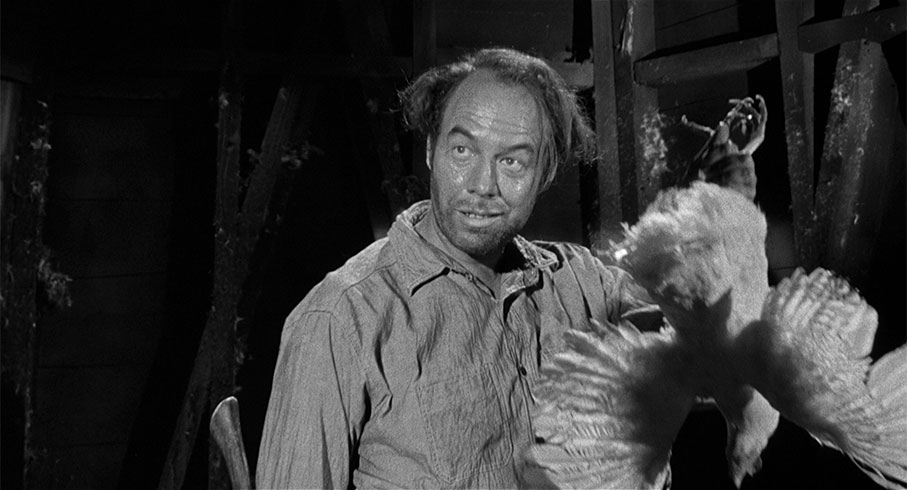
Joan Crawford Axe Test (0:37)
Test footage of Crawford using an axe to behead a dummy which then bleeds profusely from the neck, an effect that we're not given the chance to savour in the film itself.
Isolated Music and Effects Track
As the title says.
Super 8 Version (19:35)
A 4:3 framed and scratchy 8mm version that cuts the film down to less than a quarter of its original length, strips off Carol's early voiceover and replaces it with a male narrator who drifts between filling in some of the narrative gaps and stating the obvious, and somewhat oddly chooses inform us that Leo is played by George Kennedy, a service he provides for none of the other actors. As ever, we only get the barest essence of the story and a few action highlights, with sizeable chucks of the narrative and even the final scene missing (although I would argue that this was how the film was meant to end).
TV Spots (0:33)
Two TV spots in which the voice of Joan Crawford calmly urges us to see her new film. In the second, we're asked not to reveal "the surprise shock ending," thereby prodding the audience to guess what it will be.
Theatrical Trailer (2:14)
"So shocking it slashes through the limits of suspense," shout the opening captions of this solidly sensational trailer, albeit one that ends with a violent spoiler and a warning that the film depicts axe murders just after showing you one.
David DeCoteau Trailer Commentary (2:17)
Prolific exploitation movie director David DeCoteau reveals his bias up front with the claim, "I would watch a 90 minute movie of Joan Crawford's dog barking," and describes Strait-Jacket as a hilarious movie that's also kind of creepy.
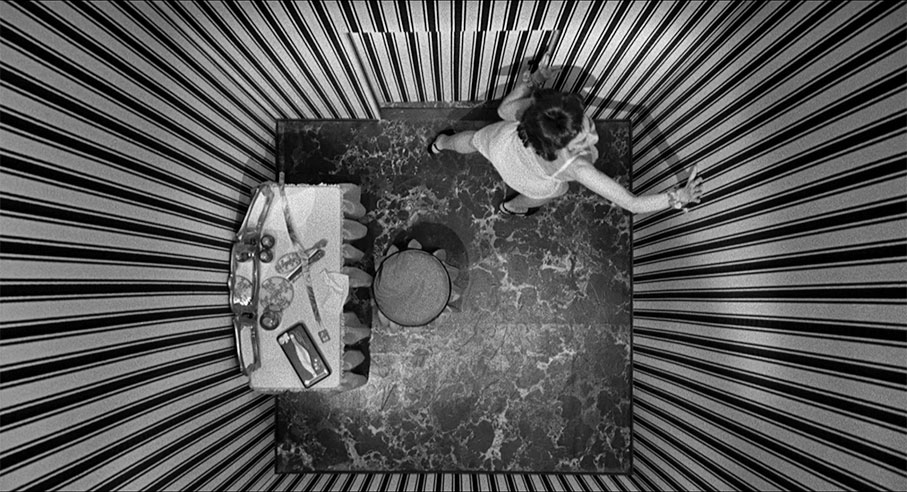
Image Gallery
39 slides of promotional images, posters and instructions for assembling your animated strait-jacket.
Booklet
Opening with a very good essay on the film by John Oliver, this impeccably produced booklet (they all are, I just forgot to mention it earlier) then moves on to the lengthiest and most entertaining extract yet from Castle's autobiography, which is peppered with recalled conversations with Joan Crawford and others. Up next is are snippets from a nine-page document issued by Columbia outlining Joan Crawford's requirements for her publicity tour to promote the film, which doesn't look much fun for those having to make the arrangements. Extracts from Columbia's promotional campaign, including those instructions for constructing an animated strai(gh)t-jacket, are followed by three contemporary reviews, one of which is really hostile to the film. Credits and promotional material have also been included.
A typically problematic set of circumstances seriously delayed this review, but while I'd usually abandon one I was so behind on, there's just too much in this one to watch and talk about (not to mention the fact that I'd already written quite a bit when things went tits-up over the holiday period) that I just had to get it finished. As with Indicator's previous William Castle box set, the sheer work that has gone into making such a comprehensive and well-featured release is worthy of celebration, as is the opportunity to see four of Castle's less widely seen and discussed films looking as pristine as they do here. Even more so than the first box set, these films definitely won't work for everyone – indeed, one of them didn't really work for me – but there's so much to enjoy here and so many high quality special features that it still gets our highest recommendation. Superb.
|